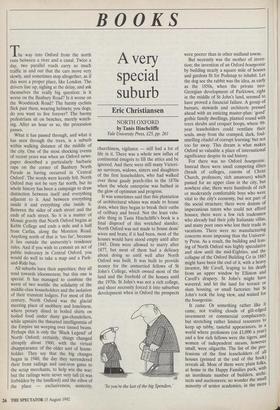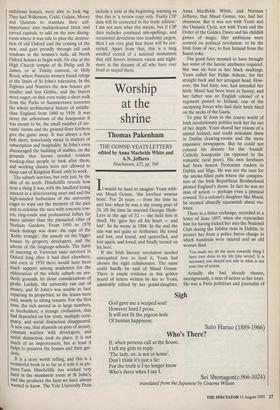BOOKS
A very special suburb
Eric Christiansen
NORTH OXFORD by Tanis Hinchcliffe
Yale University Press, £25, pp. 261 The way into Oxford from the north runs between a river and a canal. Twice a day, two parallel roads carry so much traffic in and out that the cars move very slowly, and sometimes stop altogether, as if this were a proper place, like London. The drivers line up, sighing at the delay, and ask themselves the really big question: is it worse on the Banbury Road? Is it worse on the Woodstock Road? The barmy cyclists flick past them, wearing helmets; you dogs, do you want to live forever? The barmy pedestrians sit on benches, merely watch- ing. After an hour or so, the procession passes.
What it has passed through, and what it has seen through the trees, is a suburb within walking distance of the middle of the city. One of the most shocking events of recent years was when an Oxford news- paper described a particularly barbaric rape on the corner of Banbury North Parade as having occurred in 'Central Oxford'. The words were keenly felt. North Oxford may not be very far north, but its whole history has been a campaign to draw distinction between itself and everything adjacent to it. And between everything inside it and everything else inside it. Between the sides of each street and the ends of each street. So it is a matter of Mosaic gravity that North Oxford begins at Keble College and ends a mile and a half from Carfax, along the Moreton Road. Anything north of that is 'too far', because it lies outside the university's residence rules. And if you wish to commit an act of public indecency in Central Oxford, you would do well to take a map and a Park- and-Ride bus.
All suburbs have their asperities; they all tend towards irksomeness; but this one is special. It has managed to combine the worst of two worlds: the solidarity of the middle-class householders and the isolation of their transient lodgers. For most of this century, North Oxford was the glacial meeting place of snobbery and loneliness, where penury dined in boiled shirts on boiled food under dusty gas-chandeliers, while upstairs the thwarted intelligentsia of the Empire sat weeping over tinned beans. Perhaps this is only the 'Black Legend' of North Oxford; certainly, things changed abruptly about 1960, with the virtual disappearance of the older sort of house- holder. They say that the big changes began in 1940, the day they surrendered their front railings and cast-iron gates to the scrap merchants, to help win the war; but the railings were never very tall (it was forbidden by the landlord) and the ethos of the place — exclusiveness, austerity, churchiness, vigilance — still had a lot of life in it. There was a whole new influx of continental émigrés to fill the attics and be ignored. And there were still many Victori- an survivors, widows, sisters and daughters of the first leaseholders, who had walked over those gaudy porch-tiles in the 1870s when the whole enterprise was bathed in the glow of optimism and progress.
It was sometimes said that this plantation of architectural whims was made to house dons, when they began to break their oaths of celibacy and breed. Not the least valu- able thing in Tanis Hinchcliffe's book is a final disproof of this wretched slander. North Oxford was not made to house dons' wives and brats; if it had been, most of the houses would have stood empty until after 1945. Dons were allowed to marry after 1877, but most of them had a delicacy about doing so until well after North Oxford was built. It was built to provide money for the unmarried fellows of St John's College, which owned most of the land and the freehold of the houses until the 1970s. St John's was not a rich college, and sheer necessity forced it into suburban development when in Oxford the prospects 'So you're the last of the big Spenders.' were poorer than in other midland towns.
But necessity was the mother of inven- tion; the invention of an Oxford bourgeoisie by building nearly a square mile of houses and gardens fit for Podsnap to inhabit. Let the dog see the rabbit was the idea, as early as the 1850s, when the private neo- Georgian development of Parktown, right in the middle of St John's land, seemed to have proved a financial failure. A group of bursars, stewards and architects pressed ahead with an enticing master-plan: 'good' gothic family dwellings, planted round with trees shrubs and croquet hoops, where 99- year leaseholders could ventilate their souls, away from the cramped, dark, foul- smelling citadel of corrupt learning: but not too far away. This dream is what makes Oxford so valuable a place of international significance despite its sad history. For there was no Oxford bourgeoisie. Instead there were small competing elites (heads of colleges, canons of Christ Church, professors, rich amateurs) which passed for an upper class in the city, but nowhere else; there were hundreds of rich or moderately comfortable boys who were vital to the city's economy, but not part of the social structure; there were dozens of impecunious tutors who could not afford houses; there were a few rich tradesmen who already had their jolly Italianate villas, and many poor ones who lost their trade in vacations. There were no manufacturing concerns more imposing than the Universi- ty Press. As a result, the building and leas- ing of North Oxford was highly speculative and slow until the mid-Eighties, and the collapse of the Oxford Building Co in 1883 might have been the end of it, with a heavy investor, Mr Cavell, leaping to his death from an upper window by Elliston and Cavell's drapery. St John's might have wavered, and let the land for terrace or slum housing, or small factories: but St John's took the long view, and waited for the bourgeoisie. It came. Or something rather like it came, not trailing clouds of gilt-edged investment or commercial complacency, but stretching rather limited resources to keep up tabby, tasteful appearances, in world where professors (on £1,000 a year) and a few rich fellows were the tigers, and women of independent means, however small, were oligarchs. The list of the pro- fessions of the first leaseholders of all houses (printed at the end of the book) reveals all. Most of them were plain folks, at home in the Happy Families pack, with an inordinate number of builders, archi- tects and auctioneers; no wonder the small minority of senior academics, in the more ambitious houses, were able to look big. They had Wilkinson, Codd, Galpin, Moore and Quinton to translate their self- importance into multicoloured brick and carved capitals, to add on the new dining- room where it was safe to plan the destruc- tion of old Oxford and the coming of the new, and gaze proudly through tall sash windows at the women's halls, all North Oxford houses to begin with. Or else at the High Church temple of St Philip and St James, or at Trinity convent, or Holy Rood, where Puseyite women found refuge at the limits of St John's toleration. In the Eighties and Nineties the new houses got smaller and less Gothic, and the buyers more eager; so that even today a short walk from the Parks to Summertown traverses the whole architectural history of middle- class England from 1860 to 1939. It was never the arboretum of the bourgeoisie it was meant to be, the small number of ser- vants' rooms and the ground-floor kitchens give the game away. It was always a few bob short, notoriously mean in matters of subscription and hospitality. St John's even discouraged the building of stables, on the grounds that horses needed resident working-class people to look after them; and working classes were not allowed to sleep east of Kingston Road, only to work. The suburb survives, but only just, by the skin of its teeth. Hinchcliffe reveals how near a thing it was, with the landlord losing interest in a deteriorating asset and and the high-minded barbarians of the university eager to wipe out the memory of the past and re-colonise the area with concrete tow- ers, ring-roads and professorial follies far more sinister than the pinnacled villas of Norham Gardens. From 1950 to 1970 much damage was done: the rape of the `Keble triangle', the assault on the bigger houses by property developers, and the advent of the language-schools. The habit of sneering at Victorian taste survived in Oxford long after it had died elsewhere, and even in 1970 there would have been much support among academics for the obliteration of the whole suburb on aes- thetic grounds, let alone considerations of profit. Luckily, the university ran out of money, and St John's was unable to face repairing its properties; so the leases were sold, mostly to sitting tenants. For the first time, the rich moved in in large numbers, as freeholders; a strange civilisation, that had depended on low rents, multiple occu- pancy, and social distinction disappeared. A new one, that depends on pots of money, constant warfare with developers, and social distinction, took its place. It is not much of an improvement, but at least it helps to preserve the houses and their gar- dens.
It is a story worth telling, and this is a wonderful book in so far as it tells it in pie- tures.Tanis Hinchcliffe has worked very hard in the muniment room at St John's, and she produces the facts we have always wanted to know. The Yale University Press include a note at the beginning, warning us that this is 'a review copy only. Faulty CIP data will be corrected in the trade edition.' I am not sure what this means, but if CIP data includes continual mis-spellings, and occasional deviations into academic jargon, then I am very glad that these will be cor- rected. Apart from that, this is a long awaited record of a national monument that still hovers between vision and night- mare in the dreams of all who have ever lived or stayed there.



















































 Previous page
Previous page